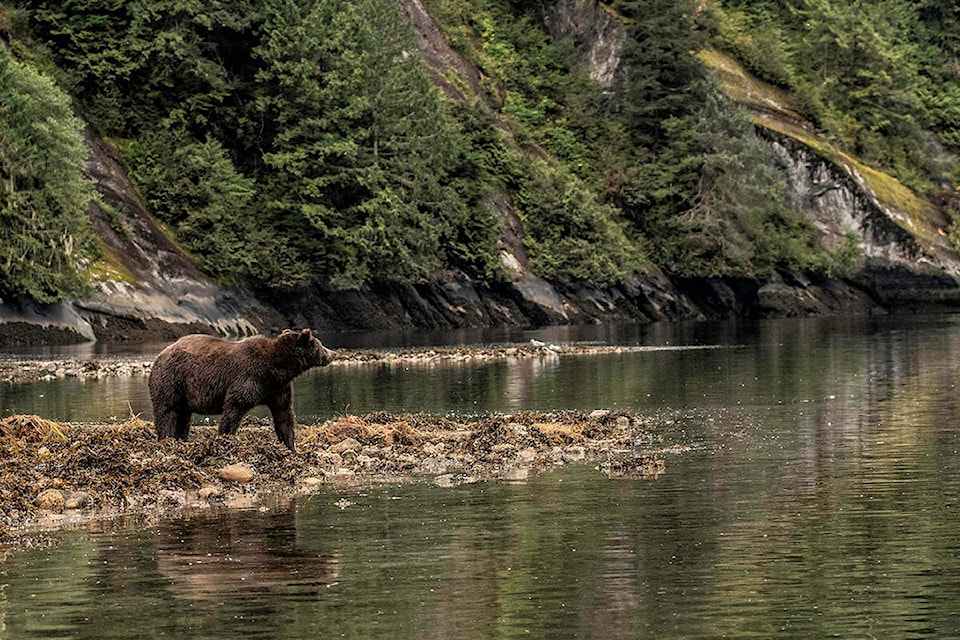Officially, grizzly bears don’t live on Vancouver Island.
But increasing numbers of anecdotal sightings are causing observers to question the conventional notion the big bears are just passing through.
Lack of studies and conclusive data on the exact number of grizzlies has left a trail of unanswered questions and prompted debate among residents and researchers.
The Ministry of Forest, Lands, Natural Resource Operations and Rural Developments does not have any historical data on the subject. Ministry spokesperson, Dawn Makarowski, said Vancouver Island has not been included in any grizzly study since it is not considered “occupied,” meaning there is no record of females birthing cubs here.
Makarowski maintained that the “two grizzlies reported north of Campbell River,” earlier in May was a “good estimate of the entire grizzly bear population on the Island.”
READ MORE: After grizzly spotted in Sayward, mayor warns not to come searching for the bears
The official numbers vary from what North Island residents have reported. In May, when grizzlies were spotted in Sayward, Mayor Bill Ives went on to say that there may be seven grizzlies in and around the community.
Multiple Island grizzly sightings in the past decade may signal deeper issues such as climate change, habitat destruction due to resource extraction and low salmon run.
While it could be argued that grizzlies are moving in and out of territories in search of food, grizzly advocate Nicholas Scapillati from Grizzly Bear Foundation said grizzlies turning up during spring cannot be about salmon and their behavior “raises questions.” However, he said that there are no conclusive answers yet.
“Why the grizzlies are moving is a phenomena we want to look at,” said Scapillati, who called for studies to be undertaken on the subject.
He said studies were essential to “ensure safety” and educate people who may not be accustomed to having grizzlies around.
Makarowski said that there were no plans to undertake any grizzly studies on the Island yet.
Chris Darimont, Associate Professor at the University of Victoria and Science Director at the Raincoast Conservation Foundation suggested that environmental changes could be one factor in rising number of sightings. Grizzlies might be moving from the mainland to seek new opportunities when food supply — affected by environmental factors — is not enough in their areas.
Another hypothesis is that there has been a growing grizzly population due to a hunting ban. In its wake, fierce competition and territorial aggression could be leading to older bears pushing younger ones out. Darimont finds this hypothesis less appealing, since grizzlies don’t reproduce that often and three years into the hunting ban is hardly enough time for a “population explosion.”
He said social media may also be contributing to an impression of more grizzlies. This, combined with increased tolerance means grizzlies are around longer rather than getting shot at five minutes after being spotted.
“People’s collective action or sentiment will also determine the population of grizzlies on Vancouver Island, ” Darimont said.
RELATED: Mali, the grizzly shot after an epic relocation, to be buried on First Nation’s land
Darimont was part of the 2014 research team that identified grizzly colonization of more than 10 islands, near Bella Bella and Klemtu, outside their management boundary.
The study also identified that the ecological, cultural and economic consequences of a distribution shift in grizzly population might be considerable. For instance, where grizzlies occur, forestry has to act differently to protect ‘high-quality’ habitats.
When asked about the lack of data, Darimont said that although he is always in favour of more research, the process of collecting Vancouver Island grizzly data is not feasible right now as it is “expensive, costs millions of dollars and does not yield quick answers.”
He indicated that other endangered species could benefit from the limited research funds.
RELATED: Great Grizzlies Go Home: North Island true tale becomes a children’s book



